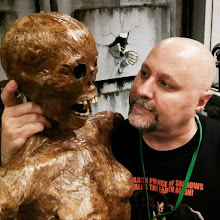Canadian author June Skinner published four novels under the pen name Rohan O'Grady, and a fifth as Ann Carleon, between 1961 and 1981. After falling out of the public eye in the early 80s, her career saw an upswing in 2010 after her third book, Let’s Kill Uncle (1963), was republished. (The book was previously adapted to film in 1966, directed by William Castle.)
She's been on my to-read list for quite some time. I decided to start with her second book, Pippin's Journal : Or, Rosemary Is for Remembrance (1962), primarily because it includes a number of illustrations by Edward Gorey--and his art is perfectly suited to Skinner's story, which is a macabre, Gothic tale that is darkly humorous at times.
I was immediately hooked by the story, and couldn't put the book down. It opens with a Canadian man, John Montrolfe, returning to Cliff House, his ancestral home in England--which was willed to him by a wealthy uncle that he never knew, for his father left at the age of 18 and never spoke of him, nor the rest of his family. The Georgian mansion has since fallen into disrepair; his uncle had lived the majority of his life in seclusion, save for an elderly, cantankerous caretaker named Nanny Beckett.
Locals believe the ghost of Guy Montrolfe, the first of his line, still haunts the grounds. He killed himself two hundred years earlier after becoming hopelessly depressed. Since then, for generations, Montrolfe men have been cursed with bitter unhappiness, and the longer they remain at Cliff House, the more reclusive they become. For John Montrolfe, the last of the line who was born and raised in Canada, the curse manifested itself physically, giving him a twisted neck and two clubbed feet.
As John adjusts to his new surroundings, he begins to feel more at home in the seclusion brought on by the long, cold winters:
As the weeks passed, the strange spell of lethargy fell deeper and deeper upon me, as though I lived in a world of shadows...there was something strange and wonderfully comforting about my room that made me feel like a bear in its den...and I began to realize why my Uncle Nicholas had spent thirty years in there. For the first time in my life, I was content.
Then one night, a young girl suddenly appears in his dreams, in that very same room, and although she never speaks, he quickly becomes fond of her. He dreams of her nightly, but after two months, she inexplicably dies in his arms. As it turns out, every man who lived in that room has dreamed of this same young girl. Was she actually a ghost? Was she trying to tell them something?
After John discovers an old journal, the story then jumps back two hundred years. This story-within-a-story comprises most of the book, and features a precocious young girl, a Byronic hero, thieves, forbidden love, a family curse, and of course, murder. This is such a great yarn and I won't spoil any of it here; however, I must mention that most characters in Skinner's story meet a very unhappy ending--which is quite dark in and of itself.
First and foremost, seek out Pippin's Journal for the story, but look for a copy with Edward Gorey's illustrations (which are reproduced below). The book has also been published under the title The Curse of the Montrolfes, and The Master of Montrolfe Hall.
June Skinner passed away in 2014; here is her obituary.






















0 comments:
Post a Comment